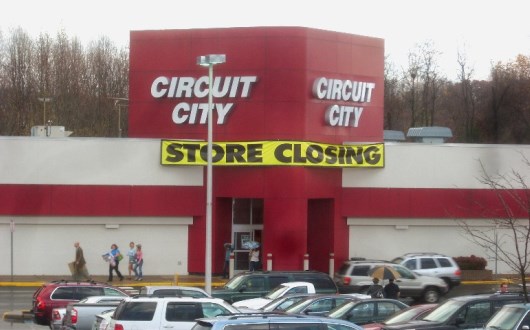 |
The Progression of Retail Store Closings
Cold Warriors loved an idea called the Domino Theory, which held that once a country “fell” to communism its neighbors would also fall, like dominoes in a chain reaction. While that didn’t happen in geopolitics, it may be happening in retailing. One retail store closing can trigger a series of events that serve as the tipping point for a host of related financial problems.
At the macro level, the first groups to feel negative effects are real estate investors and commercial property owners. For example, Morningstar estimates that there are 262 unpaid commercial mortgage-backed security (CMBS) loans that are secured by mall properties where JC Penney is an anchor tenant. Ninety-eight of those mall properties are already on Morningstar’s watch list.
Nine of those malls are on the list for a JCP store closing. All are located in small markets where replacement retailers will be hard, if not impossible, to find. If the malls go down, then it’s not just Penney employees who are out of work, but the many more people who work in other stores at those malls, some of which also house vulnerable retailers like Sears, Abercrombie & Fitch and American Eagle Outfitters.
The Community Conundrum
Retail store closings make waves throughout a community. Take Compton, California, for instance. When Circuit City closed its store there in 2008, it derailed revitalization efforts throughout the whole area, which was already in dire economic straits. It wasn’t just the direct effects of the store closing, but the message sent by the closing: business is not good here.
Consumers were affected by Circuit City closings too. The chain generated serious revenue by selling long-term product warranties. It assured warranty holders that their coverage would continue, but if a customer had a problem he would have to travel to a Circuit City outside of Compton. For the similar reasons, gift cards were harder to redeem and returns more difficult to negotiate.
In December of last year, Dominick’s, a grocery chain owned by Safeway, announced it was exiting Chicago. This left some low-income neighborhoods without a full-service grocer, where they had access to fresh, healthy food choices. To top it off, when a new food store wanted to move in to an abandoned Dominick’s, community activists learned that the closed property was encumbered by a restrictive covenant that prohibited another grocer from opening in the space.
Far-Reaching Effects
Further along the domino chain, wholesalers and suppliers are hurt when retail stores close, as are other retailers. Orders are cancelled and consumers who are now living on unemployment can’t afford to purchase anything other than necessities. Goods that people bought routinely when they had paychecks suddenly become luxury items that remain on store shelves.
It’s not fair to blame retailers for all of this. After all, it only makes sense to close stores that are under-performing, and those are most often in areas of high unemployment. In early 2012, for example, Sears Holdings closed 17 Sears or K-Mart stores in three states with substantial unemployment. They included Florida, with a 10% unemployment rate at the time, Michigan, with 9.8% unemployment, and Mississippi, with 10.5% unemployment.
A Cyclical Cycle
Worst of all, it turns out that the retail dominoes aren’t really in a chain at all. They’re in a circle, where each one influences the next and where the negative effects of store closings can build into a spiral that takes everyone further down the economic scale. People lose jobs, which communities can’t replace. These communities gradually become what labor economists call intransigent jobless areas, where the hurdles are high for attracting new business because the consumer base is low-income. This reduced purchasing power translates into fewer places to work and shop, as well as a lower tax base for local government.
In December 2013, the US Bureau of Labor Statistics reported the lowest annual retail sector unemployment rate (7.7%) since 2009, when it was a full 10%. Things are getting better and with the current round of store closings the health of the retail sector overall is improving, but it may still leave bodies on the ground, especially in areas of the country that have yet to show signs of economic recovery.
About Gevril Group
 Gevril Group, watchmaker and wholesale watch distributor, is the exclusive U.S. agent for exquisitely designed and crafted European luxury and fashion watch brands, distributing and servicing some of the best affordable luxury and Swiss watches and trendy fashion watches. Gevril Group also operates a full-service watch repair, staffed by master Swiss watchmakers. Contact Gevril Group by email or by calling 845-425-9882.
Gevril Group, watchmaker and wholesale watch distributor, is the exclusive U.S. agent for exquisitely designed and crafted European luxury and fashion watch brands, distributing and servicing some of the best affordable luxury and Swiss watches and trendy fashion watches. Gevril Group also operates a full-service watch repair, staffed by master Swiss watchmakers. Contact Gevril Group by email or by calling 845-425-9882.
Join the conversation! Follow Gevril Group on Facebook, Twitter and LinkedIn.
Please subscribe to the Gevril Group newsletter and blog digest.

